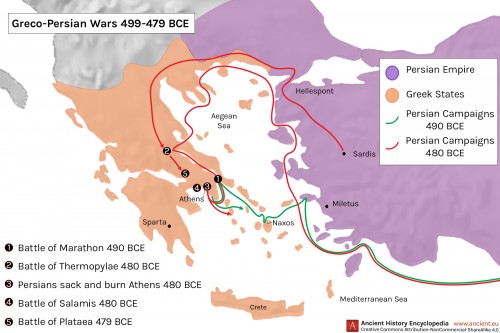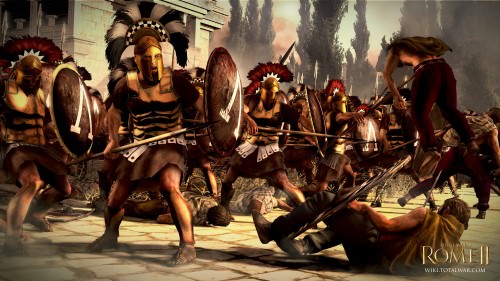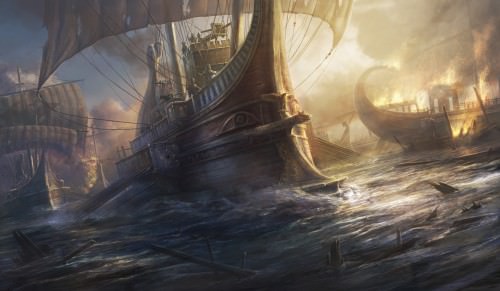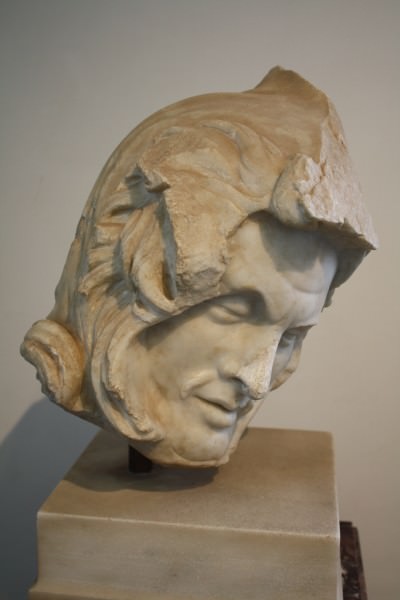Persian Wars › Paros » Ancient origins
Articles and Definitions › Contents
- Persian Wars › Antique Origins
- Paros › Ancient History
Ancient civilizations › Historical and archaeological sites
Persian Wars › Antique Origins
Definition and Origins

The Persian Wars refers to the conflict between Greece and Persia in the 5th century BCE which involved two invasions by the latter in 490 and 480 BCE. Several of the most famous and significant battles in history were fought during the Wars, these were at Marathon, Thermopylae, Salamis, and Plataea, all of which would become legendary. The Greeks were, ultimately, victorious and their civilization preserved. If they had been defeated then the western world may not have inherited from them such lasting cultural contributions as democracy, classical architecture and sculpture, theatre, and the Olympic Games.
ORIGINS OF THE WARS
Persia, under the rule of Darius (r. 522-486 BCE), was already expanding into mainland Europe and had subjugated Ionia, Thrace, and Macedonia by the beginning of the 5th century BCE. Next in king Darius' sights were Athens and the rest of Greece. Just why Greece was coveted by Persia is unclear. Wealth and resources seem an unlikely motive; other more plausible suggestions include the need to increase the prestige of the king at home or to quell once and for all a collection of potentially troublesome rebel states on the western border of the empire. The Ionian rebellion, the offering of earth and water in submission to the Persian satrap in 508 BCE, and the attack by Athens and Eretria on the city of Sardis in 499 BCE had not been forgotten either.
Whatever the exact motives, in 491 BCE Darius once again sent envoys to call for the Greeks' submission to Persian rule. The Greeks sent a no-nonsense reply by executing the envoys, and Athens and Sparta promised to form an alliance for the defence of Greece. Darius' response to this diplomatic outrage was to launch a naval force of 600 ships and 25,000 men to attack the Cyclades and Euboea, leaving the Persians just one step away from the rest of Greece.

Greco-Persian Wars
MARATHON
Darius did not lead the invasion of mainland Greece in person but put his general Datis in charge of his cosmopolitan army.Second-in-command was Artaphernes, Darius' nephew, who perhaps led the 2,000-strong Persian cavalry. The total strength of the Persian army was perhaps 90,000 men. The Greeks were led by either Miltiades or Callimachus and they commanded a total force of only between 10,000 and 20,000, probably nearer the lower figure. The long-range assault tactics of the Persian archers was to come up against the heavy infantry of Greek hoplites with their large round shields, spears and swords, and organised in a solid line or phalanx where each man's shield protected both himself and his neighbour in a wall of bronze.
WITH THEIR LONGER SPEARS, HEAVIER SWORDS, BETTER ARMOUR, AND RIGID DISCIPLINE OF THE PHALANX FORMATION THE GREEK HOPLITES WON A GREAT VICTORY AGAINST THE ODDS.
When the two armies clashed on the plain of Marathon in September 490 BCE, the Persian tactic of rapidly firing vast numbers of arrows into the enemy must have been an awesome sight but the lightness of the arrows meant that they were largely ineffective against the bronze-armoured hoplites. At close quarters the Greeks thinned their centre and extended their flanks to envelop the enemy lines. This and their longer spears, heavier swords, better armour, and rigid discipline of the phalanx formation meant that the Greek hoplites won a great victory against the odds. According to tradition 6,400 Persians were dead, for only 192 Greeks. Victory dedications and statues were erected and, for the Greeks, the Battle of Marathon quickly became the stuff of legend. Meanwhile, the Persian fleet fled back to Asia but they would be back, and next time, in even bigger numbers.
THERMOPYLAE
Within a decade, King Xerxes continued his predecessor Darius' vision, and in 480 BCE he gathered a huge invasion force to attack Greece again, this time via the pass at Thermopylae on the east coast. In August 480 BCE a small band of Greeks led by Spartan King Leonidas held the pass for three days but were killed to a man. At the same time, the Greek fleet managed to hold off the Persians at the indecisive naval battle at Artemision. Together, these battles bought Greece time and allowed for its cities to steel themselves for the bigger challenges yet to come.

Spartan Warriors
SALAMIS
The defeat at Thermopylae, though glorious, allowed the Persians to make in-roads into Greece. Consequently, many states now turned over to the Persians and Athens itself was sacked. In response, a Greek army led by Leonidas' brother Kleombrotos began to build a defensive wall near Corinth but winter halted the land campaign. The next vital engagement was going to be at sea.
In September 480 BCE at Salamis in the Saronic Gulf, the Greeks once more faced a larger enemy force. The exact numbers are much disputed but a figure of 500 Persian ships against a Greek fleet of 300 seems the most likely estimate. The hoplites had won at Marathon, now it was the turn of the trireme to take centre stage, the fast and manoeuvrable Greek warship powered by three banks of oars and armed with a bronze ram. The Persians also had triremes but the Greeks had an ace up their sleeve, the great Athenian general Themistocles. He, with 20 years of experience and the confidence from his leadership at Artemision, employed a bold plan to entice the Persian fleet into the narrow straits of Salamis and hit the enemy fleet so hard it had nowhere to retreat to.

Greek Trireme
Themistocles won a great victory and the remaining Persian ships retreated to Asia Minor. The cryptic oracle of Apollo at Delphi had been proved right: 'only a wooden wall will keep you safe' and the wooden triremes of the Greeks had done their job. But still, this was not the end. There would be one more battle, the largest ever yet seen in Greece, and it would decide her fate for centuries to follow.
PLATAEA
After Salamis Xerxes returned home to his palace at Sousa but he left the gifted general Mardonius in charge of the invasion which was still very much on. The Persian position remained strong despite the naval defeat - they still controlled much of Greece and their large land army was intact. After a series of political negotiations, it became clear that the Persians would not gain victory on land through diplomacy and the two opposing armies met at Plataea in Boeotia in August 479 BCE.
The Greeks fielded the largest hoplite army ever seen which came from some 30 city-states and numbered around 110,000.The Persians possessed a similar number of troops, perhaps slightly more but, again, there are no exact figures agreed upon by scholars. Although cavalry and archers played their part, it was, once again, the superiority of the hoplite and phalanx which won the Greeks the battle. Finally, they had ended Xerxes' ambitions in Greece.
AFTERMATH
In addition to victory at Plataea, at the roughly contemporary Battle of Mycale in Ionia, the Greek fleet led by Leotychides landed an army which wiped out the Persian garrison there and killed the commander Tigranes. The Ionian states were sworn back into the Hellenic Alliance and the Delian League established to ward off any future Persian attacks. Further, the Chersonnese controlling the Black Sea and Byzantium controlling the Bosphorus were both retaken. Persia would remain a threat with odd skirmishes and battles occurring across the Aegean over the next 30 years but mainland Greece had survived its greatest danger. In c. 449 BCE a peace was finally signed, the Peace of Callias, between the two opposing civilizations.

Dying Persian
While the Greeks were euphoric in victory, the Persian Empire was not dealt a death blow by its defeat. Indeed, Xerxes' sacking of Athens was probably enough to allow him to present himself as a returning hero but, as with other wars, there are no written records by the Persians and so their view of the conflict can only be speculated. Whatever, the Persian Empire continued to thrive for another 100 years. For Greece, however, the victory not only guaranteed her freedom from foreign rule but also permitted, soon after, an astonishingly rich period of artistic and cultural endeavour which would lay the cultural foundations of all future Western civilizations.
Paros › Ancient History
Definition and Origins

Paros is an island in the Cyclades group in the central Aegean. It is the third largest island of the Cyclades and its position on important sea routes between mainland Greece and the coast of Asia Minor made it an important centre from the early Bronze Age through to Roman times. The island was also famous for the high quality of its marble which became a popular material for sculptors and architects throughout antiquity.
BRONZE AGE PAROS
First inhabited from c. 3200 BCE (or perhaps even earlier), important settlements from the Early Cycladic Period include those at Drios, Avyssos, Galana, Gremna, Kampos, and Plastiras. The relatively high level of culture in the early Bronze Age is attested by the wealth of decorated pottery finds and in Cycladic sculpture which produced elegant marble figures rendered in a minimalistic style.
At the island's capital Parikia (Paroikia) on the west coast the first indications of settlement date to the early 2nd millennium BCE and the area was continuously occupied through Minoan and Mycenaean times and settled by colonists from Attica c.1000 BCE being occupied until around 700 BCE. On the north coast at Naoussa there was a major Mycenaean settlement which prospered in the 13th century BCE but was destroyed in c. 1200 BCE. Nevertheless, the site was reoccupied from the 10th century BCE and once again enjoyed a period of prosperity from the 9th to the mid-7th century BCE. Koukounaries on the east coast was also an important Mycenaean centre in the 13th and 12th centuries BCE and continued into the mid-7th century BCE. It was here at Koukounaries that the oldest temple on the island was built, the temple to Athena dating to c. 700 BCE and which survived into Classical times.
THE IMPORTANCE OF THE SEA TO THE ISLAND'S TRADE & CULTURE IS EVIDENCED IN EARLY PAROS COINS WHICH DEPICT DOLPHINS.
TRADE & PROSPERITY
From 700 to 500 BCE Paros prospered as a trading centre based on maritime links, indeed the Parians are credited with inventing a new type of vessel, a light ship known as a paron. Agricultural produce from the fertile plains on the island and crafts were traded between the Cycladic islands. The importance of the sea to the culture is evidenced in early Paros coins which depict dolphins and the island's wealth resulted in the founding of a colony on Thasos in the northern Aegean in c. 680 BCE which in turn brought more riches as gold mines were opened up there. Paros also participated in the founding of the trading city of Parion (Parium) on the Hellespont and notable cultural contributions to the wider Greek world included the works of the 7th century BCE poet Archilochos (who even had a temple, the Archilocheion, dedicated to him in the Archaic and Classical periods) and the creation of the 'Melian' style of pottery. In 385 BCE Paros, with support from Syracuse, also founded the colony of Pharos (modern Hvar) off the Dalmatian coast. By the 4h century BCE the island may well have boasted as many as 12,000 citizens.
Paros also became famous for its marble - the lychnitis - which from the Archaic period was exported all over the Greek world and even beyond. Famed for its high degree of translucency it was a pure white and became a favourite of architects and sculptors. For example, the great masterpieces the 4th century BCE Hermes of Praxiteles at Olympia and the 2nd century BCE Nike of Samothrace are sculpted in marble from Paros. The island also had its own celebrated school of sculpture and produced such famous sculptors as Agorakritos in the 5th century BCE and Skopas in the 4th century BCE, who contributed to the temple of Athena at Tegea and the temple of Artemis at Ephesos, respectively. Parian sculptors continued to find ready employment well into the Roman period from which many marble sarcophagi survive. The Archaeological Museum of Parikia also has two outstanding examples of the talent of Parian sculptors: the larger-than-life 6th century BCE winged Gorgon and a 5th century BCE statue of Nike.

Cycladic Figurine c. 2400 BCE
REGIONAL CONFLICTS
Paros was not always peaceful despite or perhaps even because of the island's prosperity. Conflicts with long-time rival Naxos, a neighbouring island in the Cyclades, often ended in defeat and in 489 BCE the Athenian general Miltiades besieged the island for 26 days with a fleet of 70 ships, albeit, without any great success and even getting wounded for his troubles. The pretext for the attack was the fact that Paros had been pro-Persian during the Persian wars and was accused of supplying ships for the Persians before the Battle of Marathon. In 478 BCE Paros, was, however, compelled to join the Athenian Confederacy and the island became one of the biggest financial contributors to it. In 403 BCE with the end of the Peloponnesian War Paros came under Spartan control until the Athenians once again re-established themselves in the Cyclades and Paros was made to join the second Athenian Confederacy or Delian League in 374 BCE. With the Macedonian invasion of Greece the League was dissolved and Paros was declared a free and autonomous polis or city-state. In 145 BCE the island came under Roman control and continued to thrive. From the 7th century CE the island, along with its Cycladic neighbours, became a headquarters for pirates and its long period of prosperity finally came to an end.
PAROS ARCHAEOLOGICAL SITES
The sanctuary to Apollo and Artemis - the Delion - at Pairikia was founded in the late 9th century BCE and continued to be used until the 5th century BCE. There was another sanctuary dedicated to Apollo south of Parikia, an Asklepion sanctuary was founded in the 4th century BCE and on the hill of Kastro there was sanctuary dedicated to Athena, the patron of Parikia with a temple built c. 525 BCE. Measuring 32.86 m by 16.5 m and with a façade of six Ionic columns only the eastern part survives today. Pieces of the temple were reused in the medieval Venetian castle which also cannibalised parts of the stoa which had been repaired and extended in the 2nd century CE. The ancient pieces of masonry such as architraves and column drums are clearly visible in the walls of the castle today. Similarly, a temple to Hestia, another to Dionysos and Persephone, and a theatre, all attested to in written records, have since disappeared, their valuable stonework having been reused in later buildings or the sites built over.
Other important archaeological discoveries include parts of Parikia's once extensive fortifications from the 6th century BCE which had surrounded the city creating a perimeter of 2.5 km. There are also various Roman public buildings, Hellenisticvillas, a Hellenistic pottery workshop and a cemetery just outside Parikia which had been in use from the 8th century BCE to the 3rd century CE. Finally, the town of Parikia is still dominated by the fine church of Panayia Ekatondapyliani or Katapoliani, first constructed in the 6th century CE by Justinian and which claims to have 100 entrances and was built on the site of the Roman gymnasium.
MAP
LICENSE:
Article based on information obtained from these sources:with permission from the Website Ancient History Encyclopedia
Content is available under License Creative Commons: Attribution-NonCommercial-ShareAlike 3.0 Unported. CC-BY-NC-SA License